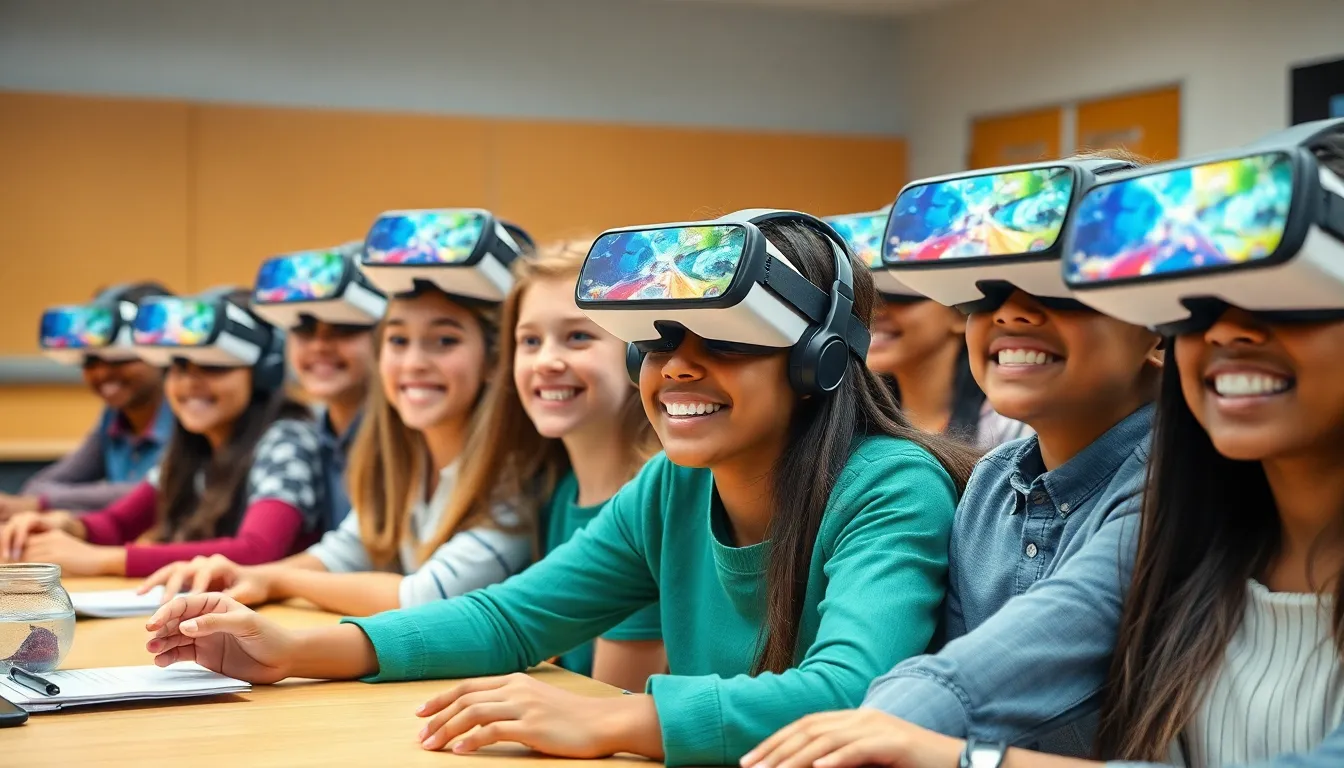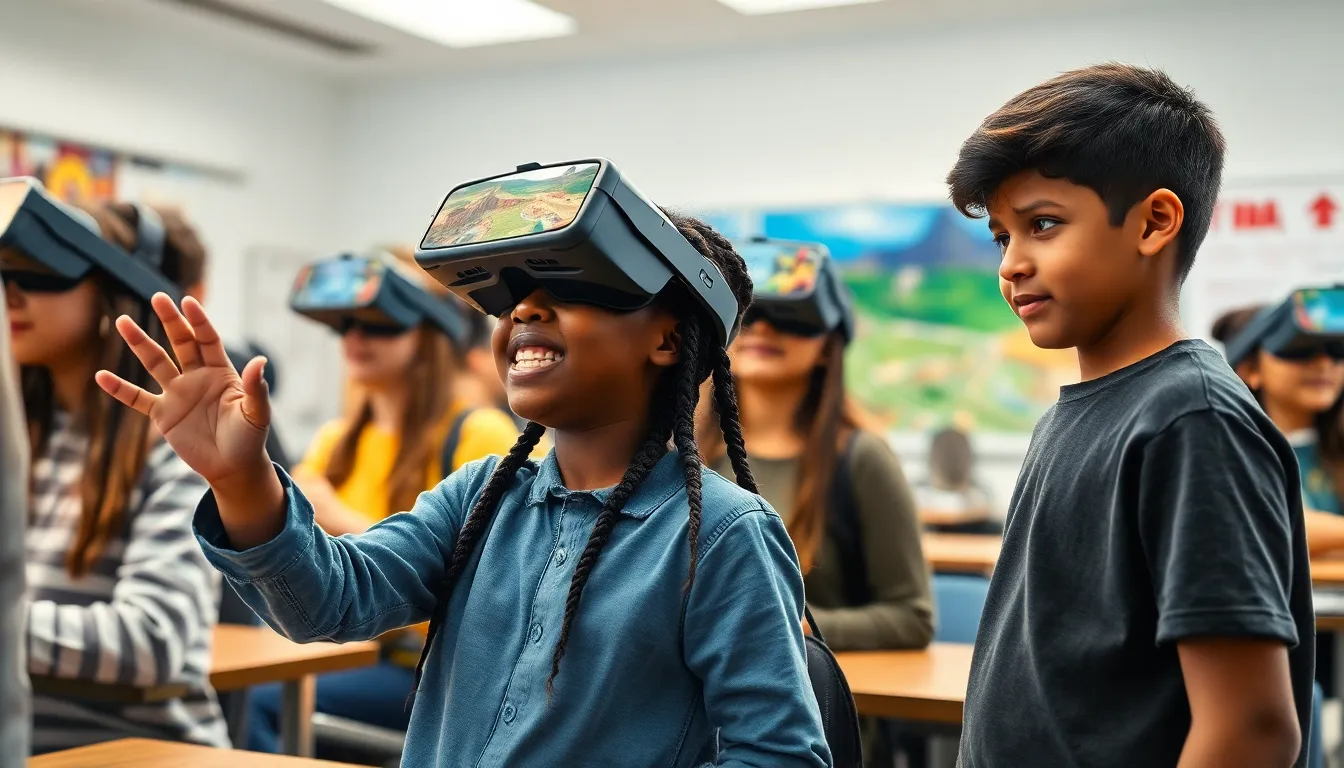Virtual reality is revolutionizing education, transforming traditional classrooms into immersive learning environments. With the ability to transport students to different worlds, VR enhances engagement and retention like never before. Imagine exploring ancient civilizations or diving into the depths of the ocean—all from the comfort of a classroom.
As educators seek innovative ways to captivate their students, VR offers a powerful tool that appeals to diverse learning styles. It fosters collaboration, stimulates creativity, and encourages critical thinking by providing hands-on experiences that textbooks simply can’t match. The integration of VR in education isn’t just a trend—it’s a glimpse into the future of learning, where boundaries are pushed and possibilities are endless.
Table of Contents
ToggleOverview of VR in Education
Virtual reality (VR) reshapes educational experiences by immersing students in interactive environments. It enables learners to visualize complex concepts, making abstract ideas more tangible. VR applications range from virtual field trips to architectural simulations, supporting diverse subjects like science, history, and art.
Virtual reality fosters active participation. It encourages students to engage directly with content, enhancing retention rates compared to traditional teaching methods. By simulating real-life scenarios, VR provides practical experience in fields like medicine and engineering.
Educators leverage VR to address various learning preferences. Kinesthetic learners benefit from immersive, hands-on activities. Visual learners gain better understanding through 3D models and simulations. Auditory learners enjoy narrated experiences, integrating multiple senses for comprehensive learning.
Collaborative VR platforms enable group projects, promoting teamwork and communication. Students can work together on simulations, encouraging peer interaction regardless of physical location. By using VR, educational institutions prepare students for a technology-driven future, ensuring they develop critical skills essential for career success.
Statistics highlight the effectiveness of VR in education. A report by the University of Maryland reveals that students demonstrate a 76% retention rate when using VR versus 10% retention with traditional methods. Additionally, 92% of educators recommend VR for enhancing student engagement, showcasing its increasing significance in modern educational settings.
Benefits of VR in Education

Virtual reality (VR) offers numerous advantages for educational settings, significantly transforming learning experiences. It enhances engagement, motivation, and retention through innovative methods tailored to diverse student needs.
Enhanced Engagement and Motivation
Engagement in learning increases significantly with VR technologies. Students interact with content in dynamic and immersive ways, capturing their attention more effectively than traditional methods. They participate in virtual simulations, explore interactive environments, and engage in role-playing scenarios, further promoting interest and excitement. Studies indicate that immersive VR experiences can lead to a 30% increase in student motivation. This heightened engagement stimulates curiosity, prompting students to explore subjects more deeply.
Improved Learning Retention
Learning retention improves remarkably when students use VR. The immersive nature of VR provides hands-on experiences that solidify understanding, making abstract concepts more concrete. Research shows that students using VR demonstrate a retention rate of 76%, in comparison to just 10% with conventional teaching approaches. By simulating real-life situations, VR allows students to apply knowledge practically, reinforcing lessons and improving long-term retention. This innovative approach equips learners to recall information efficiently, contributing to overall academic success.
Applications of VR in Education
Virtual reality (VR) serves multiple applications in education, transforming learning experiences and providing students with unique opportunities to engage with content more deeply.
Virtual Field Trips
Virtual field trips offer students immersive experiences that transport them to historical sites, natural wonders, and cultural landmarks worldwide. Through VR, learners can explore places like the Louvre Museum, the Great Barrier Reef, or the surface of Mars without leaving the classroom. This approach not only enhances cultural awareness but also allows students to study subjects, such as geography or history, in a dynamic context. Research indicates that virtual field trips result in a 90% engagement rate, making learning more impactful.
Simulations and Role-Playing
Simulations and role-playing activities allow students to practice real-world scenarios in a controlled environment. In fields like medicine, students can perform virtual surgeries, gaining hands-on experience without risking patient safety. Similarly, business students can engage in simulated market scenarios, applying theoretical concepts to practical situations. These VR applications enhance critical thinking and decision-making skills. Reports show that 85% of students feel more confident in their skills after participating in VR simulations, directly linking these experiences to improved academic performance.
Challenges of Implementing VR in Education
Implementing virtual reality (VR) in education presents several challenges that educators and institutions must navigate. Key obstacles include cost and accessibility issues, along with technological limitations.
Cost and Accessibility Issues
Costs associated with VR technology can be prohibitive for many educational institutions. Hardware such as VR headsets, computers, and software licenses can total thousands of dollars, making it difficult for schools, especially those with limited budgets, to adopt VR programs. Additionally, maintenance and updates for VR hardware and software create ongoing financial commitments.
Accessibility also poses a significant barrier. Not all students have equal access to the technology required for VR experiences. For instance, schools in underfunded areas might lack high-speed internet or the latest devices, resulting in disparities that hinder equitable learning opportunities. According to a report by the International Society for Technology in Education, nearly 20% of schools lack sufficient technology resources to support advanced learning tools like VR.
Technological Limitations
Technological limitations further complicate the integration of VR in education. Many existing VR platforms require powerful computers, which may not be available in all classrooms. This reliance on advanced equipment restricts the number of students who can participate in immersive learning experiences simultaneously.
Moreover, VR software often needs ongoing updates and adjustments to align with evolving educational standards and user feedback. Developers must ensure that content is accessible for diverse learners, including those with special needs. A lack of standardized content and compatibility across different systems can also deter institutions from adopting VR solutions, as schools may be hesitant to invest in technology that isn’t reflective of their curriculum or student needs.
Future of VR in Education
Ongoing advancements in VR technology promise to reshape educational landscapes further. Enhanced graphics and more immersive experiences allow students to engage with content in unprecedented ways. Educational institutions plan to integrate AI-driven VR scenarios that adapt to individual learning paces and preferences, making the educational experience more personalized.
Collaborative VR environments are likely to see widespread adoption. Students may participate in virtual study groups, working together in shared spaces regardless of location. Such environments promote social interaction and teamwork, essential skills for the modern workplace. The potential for real-time feedback during these collaborative exercises will also help educators assess student progress more accurately.
Innovative curricula incorporating VR are being developed to address critical thinking and problem-solving skills. Subjects like science, mathematics, and engineering can benefit immensely from virtual labs where students conduct experiments without physical limitations. This hands-on approach lets students explore complex theories and concepts, reinforcing understanding through practical experience.
Increased investment in VR for education is expected to decrease equipment costs over time. As the technology becomes more affordable, smaller institutions and those in underserved areas will gain access to VR resources. Partnerships between tech companies and educational providers may result in broader distribution of VR tools and training for educators.
Data collection within VR environments offers new insights into learning behaviors. Educators can gather information on student interactions, revealing areas for improvement and tailoring instruction to meet diverse needs. This ability to analyze engagement and retention metrics will drive continuous enhancements in teaching strategies.
The future of VR in education hinges on addressing current challenges, such as accessibility and curriculum standardization. Efforts to establish best practices and guidelines will promote widespread adoption, ensuring that all students benefit from VR opportunities regardless of their socio-economic backgrounds. Ongoing research will validate the effectiveness of VR applications, solidifying their role in modern education.
VR is set to revolutionize educational approaches, making learning more engaging, inclusive, and effective. The implications of enhanced immersion, personalized learning, and collaborative opportunities position VR as a cornerstone of future educational paradigms.
The integration of VR in education marks a significant shift in how students engage with learning materials. By creating immersive environments that cater to various learning styles, VR not only enhances retention but also fosters a deeper understanding of complex concepts. As technology continues to evolve, the potential for VR to transform educational experiences is immense.
Addressing challenges like cost and accessibility will be crucial in ensuring that all students can benefit from these advancements. The future promises a more inclusive and personalized approach to education, driven by innovative VR applications. With ongoing investment and development, VR is poised to redefine learning, making it more engaging and effective for generations to come.





